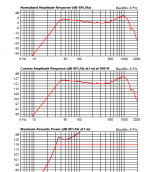I listen to anything from classic rock, 60's pop, some metal, some folk. Plan to listen to jazz. For the woofer and enclosure design, I'm not clear on where to design the F3 point for the speaker. I want to cover the bass, but not go too low to where the cabinets get crazy large.
I'm looking at low Qts, Vas 15", high eff. pro sound drivers in a ported cab of around 5 Cu ft.
Is an F3 point of 43Hz and F10 of 33Hz reasonable?
Thanks for any tips!
I'm looking at low Qts, Vas 15", high eff. pro sound drivers in a ported cab of around 5 Cu ft.
Is an F3 point of 43Hz and F10 of 33Hz reasonable?
Thanks for any tips!
You pay about a –9dB toll in efficiency each time you lower the lf corner an octave with the same cabinet volume.I listen to anything from classic rock, 60's pop, some metal, some folk. Plan to listen to jazz. For the woofer and enclosure design, I'm not clear on where to design the F3 point for the speaker. I want to cover the bass, but not go too low to where the cabinets get crazy large.
I'm looking at low Qts, Vas 15", high eff. pro sound drivers in a ported cab of around 5 Cu ft.
Is an F3 point of 43Hz and F10 of 33Hz reasonable?
Thanks for any tips!
To me, it is worth it, 43 Hz F3 is adequate for 60's pop, but not for jazz or metal.
The low E on a four string bass is 41 Hz, the low B on a five string, 31 Hz.
The low B is common now.
After having heard it flat, having the low B 10 dB down (half as loud) just does not cut it for me anymore.
Using a pair of Lab 12 in around a 6 cubic foot enclosure Fb36 will get you an F3 around 31 Hz.
They will beat the LF extension and efficiency of most pro dual 18" for LF output for the size.
Attachments
Last edited:
Are your graphs from a room? I'm not sure what WinISD software is telling me (a certain space type or anechoic). Wouldn't I gain quite a bit of LF in a room?
I have a set of DIY 1.5" cu ft speakers designed for f3 at 50 Hz, but when I play sine wave tones, they have strong output to 37 Hz and even a bit at 30Hz which I find remarkable.
I have a set of DIY 1.5" cu ft speakers designed for f3 at 50 Hz, but when I play sine wave tones, they have strong output to 37 Hz and even a bit at 30Hz which I find remarkable.
Are your graphs from a room? I'm not sure what WinISD software is telling me (a certain space type or anechoic). Wouldn't I gain quite a bit of LF in a room?
I have a set of DIY 1.5" cu ft speakers designed for f3 at 50 Hz, but when I play sine wave tones, they have strong output to 37 Hz and even a bit at 30Hz which I find remarkable.
The graphs are half space, the measured response outdoors in half space is nearly identical. Two subs totaling the same size may give better in room response, there are many who prefer multiple subs over one to even out room response.
Speaker placement, room dimensions and size will all have large effects on the frequency response of a speaker system. A very small room will exhibit "cabin gain", progressive increase in low frequency, which may compensate for a speaker's falling response down low.
Playing sine wave tones, move your dB meter (or ears) around, you will find large variations in the "strong" response.
- Status
- Not open for further replies.
